

AHA Infographic: Love Your Heart Help Your Brain. Researchers Study How Heart Stem Cells Work. Researchers from Cedars-Sinai Heart Institute have discovered the heart stem cell components responsible for regenerating and repairing the heart.

Stem cells are are cells that can transform itself into a higher biological component such as muscle, tissue or an organ. There are different type of stem cells that are exclusive to a biological system. Vitamin C Lowers Risk of Hemorrhagic Stroke. The American Academy of Neurology released a study citing that Vitamin C, often found in citrus fruits, lowers risk of hemorrhagic stroke.
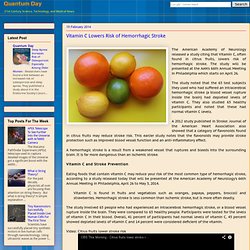
The study will be presented at the AAN's 66th Annual Meeting in Philadelphia which starts on April 26. The study noted that the 65 test subjects they used who had suffered an intracerebral hemorrhagic stroke (a blood vessel rupture inside the brain) had depleted levels of vitamin C. They also studied 65 healthy participants and noted that these had normal vitamin C levels. A 2012 study published in Stroke: Journal of the American Heart Association also showed that a category of flavonoids found in citrus fruits may reduce stroke risk. This earlier study notes that the flavonoids may provide stroke protection such as improved blood vessel function and an anti-inflammatory effect.
Men Lead A Better Quality Of Life After A Stroke Than Women. Researchers at Wake Forest Baptist Medical Center find that men lead a better quality of life than women after have a stroke.

Three months after suffering a stroke, the study shows that women were more likely than men to report problems with mobility, pain/discomfort, and anxiety/depression. According to the American Heart Association. women face higher risk of stroke than men with 1 out of 5 women experiencing a stroke sometime in her life. They also note that 55,000 more women than men suffer from a stroke each year. It is the 3rd cause of death for women while it is the 4th for men. What is Atrial Fibrillation - An American Heart Association Infographic. The American Heart Association released an infographic on atrial fibrilation to further inform people as well as bridge knowledge gaps on the condition.
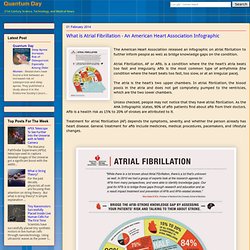
Atrial Fibrillation, AF or Afib, is a condition where the the heart's atria beats too fast and irregularly. Afib is the most common type of arrhythmia (the condition where the heart beats too fast, too slow, or at an irregular pace). The atria is the heart's two upper chambers. In atrial fibrillation, the blood pools in the atria and does not get completely pumped to the ventricles, which are the two lower chambers. Unless checked, people may not notice that they have atrial fibrillation. Treatment for atrial fibrillation (AF) depends the symptoms, severity, and whether the person already has heart disease. American Heart Association Recommendations for Physical Activity - Infographic.
The American Heart Association released an infographic on its recommendations for adult physical activity to maintain a healthy lifestyle.
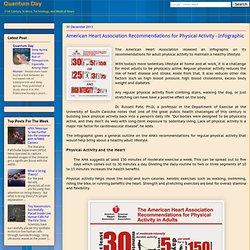
With today's more sedentary lifestyle at home and at work, it is a challenge for most adults to be physically active. Regular physical activity reduces the risk of heart disease and stroke. Aside from that, it also reduces other risk factors such as high blood pressure, high blood cholesterol, excess body weight and diabetes. Any regular physical activity from climbing stairs, walking the dog, or just stretching can have have a positive effect on the body. Dr. American Heart Association Releases 2014 Heart Disease and Stroke Statistical Update. The American Heart Association (AHA) with the Center for Disease Control and Prevention (CDC), the National Institutes of Health (NIH), and other government agencies compiled the 2014 Heart Disease and Stroke Statistical Update.
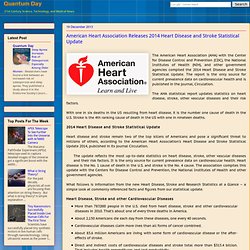
The report is the only source for current prevalence data on cardiovascular health and is published in the journal, Circulation. The AHA statistical report updates statistics on heart disease, stroke, other vascular diseases and their risk factors. With one in six deaths in the US resulting from heart disease, it is the number one cause of death in the U.S. Energy Drinks Cause Heart To Significantly Increase Contraction After One Hour. An ongoing study is measuring the effect of drinking energy drinks on heart function using cardiac magnetic resonance imaging (MRI).
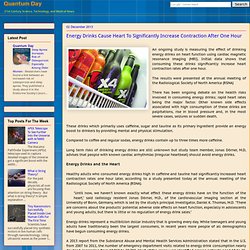
Initial data shows that consuming these drinks significantly increase heart contraction rates after one hour. The results were presented at the annual meeting of the Radiological Society of North America (RSNA) There has been ongoing debate on the health risks involved in consuming energy drinks; rapid heart rates being the major factor. New Device Brings Higher Level Of Recovery Time in Movement For Stroke Patients. A new device based on a functional electrical stimulation system (FES) and a Brain Controlled Interface (BCI) called the Closed-Loop Neural Activity-Triggered Stroke Rehabilitation Device allows stroke patients to move otherwise paralyzed upper extremities, such as arms and hands, by converting their thoughts to electrical impulses to move these limbs.
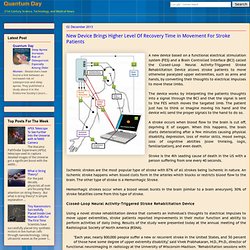
The device works by interpreting the patients thoughts into a signal through the BCI and that the signal is sent to the FES which moves the targeted limb. The patient just has to think or imagine moving his hand and the device will send the proper signals to the hand to do so. A stroke occurs when blood flow to the brain is cut off, depriving it of oxygen. When this happens, the brain starts deteriorating after a few minutes causing physical disability, depression, loss of motor skills, mood swings, loss of cognitive abilities (slow thinking, logic, familiarization), and even death.
Dr. Miracle Anti Cancer Molecule JQ1 Found To Also Protect and Treat Heart Failure. A protein molecule previously known to have anti-cancer properties have recently been discovered to also be able to treat and protect against heart failure.

JQ1, initially developed as a male contraceptive drug, has shown potential to treat cancer and even HIV. It does this by inhibiting cells from behaving abnormally (as shown on the embedded video). JQ1 attacks by targeting the BRD4 cancer-causing gene. Protein GDF-11 Reverse Aging of the Heart. Researchers at the Harvard Stem Cell Institute have discovered that the protein GDF-11 have a restoring effect on the aging process of the heart.
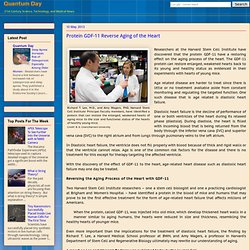
The GDF-11 protein can restore enlarged, weakened hearts back to its young and healthy status as evidenced in their experiments with hearts of young mice. Age related disease are harder to treat since there is little or no treatment available aside from constant monitoring and regulating the targeted function. One such disease that is age related is diastolic heart failure. Recovering After a Stroke: A Patient and Family Guide Consumer Guide : A review. Available online, the “Recovering After a Stroke: A Patient and Family Guide Consumer Guide” by the US Agency for HealthCare Research and Quality published May 1995 is a very handy and useful tool to consult about caring for a loved one who suffered a stroke.
As defined in the guide, “A stroke is a type of brain injury. Symptoms depend on the part of the brain that is affected. People who survive a stroke often have weakness on one side of the body or trouble with moving, talking, or thinking. Most strokes are ischemic (is-KEE-mic) strokes. AHA News: Women's Awareness of Heart Disease On The Rise But Still Needs Improvement. According to a study by the American Heart Association, women's awareness of the risks of heart disease has doubled in the last fifteen years. But for minorities and younger women, that does not seem to be the case. AHA Infographic: Stroke By The Numbers. Stem Cell Therapy Shows Improved Stroke Recovery. A recent stem cell experiment in stem cell treatment showed fast and improved functional recovery after a stroke within 24 hours.
Stem cells are cells that can differentiate to other type of cells, usually a higher class such as tissues and organs. Various body systems generate different kind of stem cells. Blood stem cells which are used to generate red blood cells come from the bone marrow. Stroke is Preventable, Treatable, and Beatable: A Stroke Infographic By The AHA and ASA. According to the American Heart Association (AHA), stroke is the leading cause of long term disability among adults in the U.S. Every 40 seconds, someone suffers a stroke. In the U.S alone, 795,000 Americans suffer a new or recurrent stroke each year. Stroke is the fourth leading cause of death with someone dying of a stroke every four minutes. It kills about 128,000 people annually. But stroke can be prevented. AHA Study Shows Eating Flavonoid Rich Berries Reduce Heart Attack Risk in Women by 30% American Heart Association Infographics on Heart Disease.
Post Stroke Depression Increases Risk of Death By A Factor of Three. Virulent Form of Helicobacter pylori (H. pylori) Bacteria May Protect Against Stroke and Cancer. Being Aware and Preventing Heart Disease: An Infographic From The American Heart Association. American Heart Association Names Top 10 Advances in Heart Disease and Stroke Research for 2012. Children With Heart Devices May Benefit From Psychotherapy In Coping With Lower Quality of Life.
Children with heart conditions and carry an implantable cardiac device (ICD) may benefit from psychotherapy to deal with a lower quality of life based on their self perception, self worth, and athletic ability. Transcendental Meditation Increases Survival Rate in Heart Patients And Reduces Risk of Stroke and Heart Attack. iPhone App Takes ECG Reading For Monitoring Heart and Atrial Fibrillation Diagnosis. An iPhone application that takes electrocardiogram (ECG) readings that is vital to diagnosing for atrial fibrillation was presented at the American Heart Association Scientific Sessions 2012. Piezoelectricity Allows Pacemaker To Operate Without A Battery. Canadian Scientists Discover Cause For High Levels of Bad Cholesterol (LDL) Scientists have discovered the cause of high cholesterol in the body.
With this discovery, it could lead to better prevention and treatment of cardiovascular disease. Cholesterol Cholesterol is classified as a waxy steroid of fat. Stroke Victims Can Improve Cognitive Ability By 50% Through Physical Exercise In Six Months. Using Extreme Cold To Treat Malfunctioning Heart Tissues. Quantum Day : Cardiovascular Mortality Risk In Obstructive Sleep Apnea (OSA) Increases With Age. Popular Flavonoid, Rutin, As Preventive Therapy Against Blood Clots, Strokes and Heart Attacks. Quantum Day : Anti Blood Clot Medication Prasugrel Is as Safe as Clopidogrel With Long-term Treatment Of ACS. Blood Type May Be A Factor In Coronary Heart Disease. MRI and Magnetic Particles Track Cells In the Body And Monitor Heart Treatments. Study Shows No Benefit In Using Magnesium Sulphate Treatment For Hemorrhagic Stroke. Link Between Low DHEA Levels and Cardiovascular Disease. Declining Testosterone Levels Due More To Health and Behavior Than Age.
Antioxidant Glutathione Peroxidase (GPx) Reduce Risk of Cardiovascular Disease. Bio Nanotechnology Develops Nanocontainers For Effective Treatment of Atherosclerosis. Cholesterol Control Drug Statin Prevents Cancer in Heart Transplant Patients. Zio® Patch Studied For Use In Diagnosing Irregular Heartbeat or Arrhythmia. Flavanols In Dark Chocolate Help Against Cardiovascular Disease. Canned Food Cheaper and Offers As Much Nutrition As Fresh Food. Nonsteroidal Anti Inflammatory Drugs (NSAIDs) and Cardiovascular Risk Explained. Scar Tissue Formed After Heart Attack Turned To Heart Muscle Tissue Without The Use of Stem Cells. Eating Eggs Are Healthy and Beneficial To Metabolic Syndrome and Satiety.